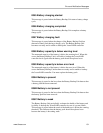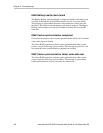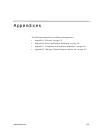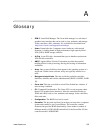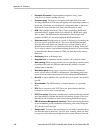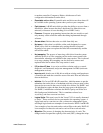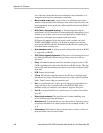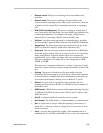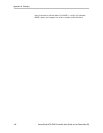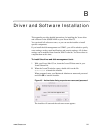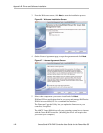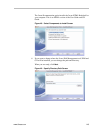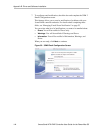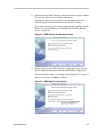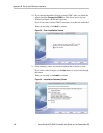
www.3ware.com 139
• Remove a drive. The process of making a drive unavailable to the
controller.
•
Remove a unit. The process of making a unit unavailable to the
controller and the operating system. After a unit is removed it can be hot
swapped out of the system.This is sometimes referred to as exporting a
unit.
•
RLM (RAID Level Migration). The process of using an existing unit of
one or more drives and converting it to a new RAID type without having
to delete the original unit. For example, converting a single disk to a
mirrored disk or converting a RAID 0 unit to a RAID 5 unit.
•
Self-test. A test that can be performed on a scheduled basis. Available
self-tests include Upgrade UDMA mode and Check SMART Thresholds.
•
Stagger time. The delay between drive groups that will spin up, at one
time, on a particular controller. (9000 series controllers only)
•
Stripe size. The size of the data written to each disk drive in RAID unit
levels that support striping. The size of stripes can be set for a given unit
during configuration. In general, smaller stripe sizes are better for
sequential I/O, such as video, and larger strip sizes are better for random
I/O (such as databases). The stripe size is user-configurable at 64KB,
128KB, or 256KB.
This stripe size is sometimes referred as a a “minor” stripe size. A major
stripe size is equal to the minor stripe size times the number of disks in the
unit.
•
Striping. The process of breaking up files into smaller sizes and
distributing the data amongst two or more drives. Since smaller amounts
of data are written to multiple disk drives simultaneously, this results in
an increase in performance. Striping occurs in RAID 0, 5, and 10.
•
Subunit. A logical unit of storage that is part of another unit. For
example, the mirrored pairs (RAID 1) in a RAID 10 unit are subunits of
the RAID 10 unit.
•
UDMA mode. UDMA mode is a protocol that supports bursting data up to
133 MB/sec with PATA disk drives and 1.5Gb/sec and 3.0 Gb/sec with
SATA disk drives.
•
Unit ID. A unique identifier for a specific unit in a system.
•
Unit Number. The SCSI number, or channel number, of a particular unit.
•
Unit. A logical unit of storage, which the operating system treats as a
single drive. A unit may consist of a single drive or several drives. Also
known as an array.
•
Verify. A process that confirms the validity of the redundant data in a
redundant unit. For a RAID 1 and RAID 10 unit, a verify will compare the



